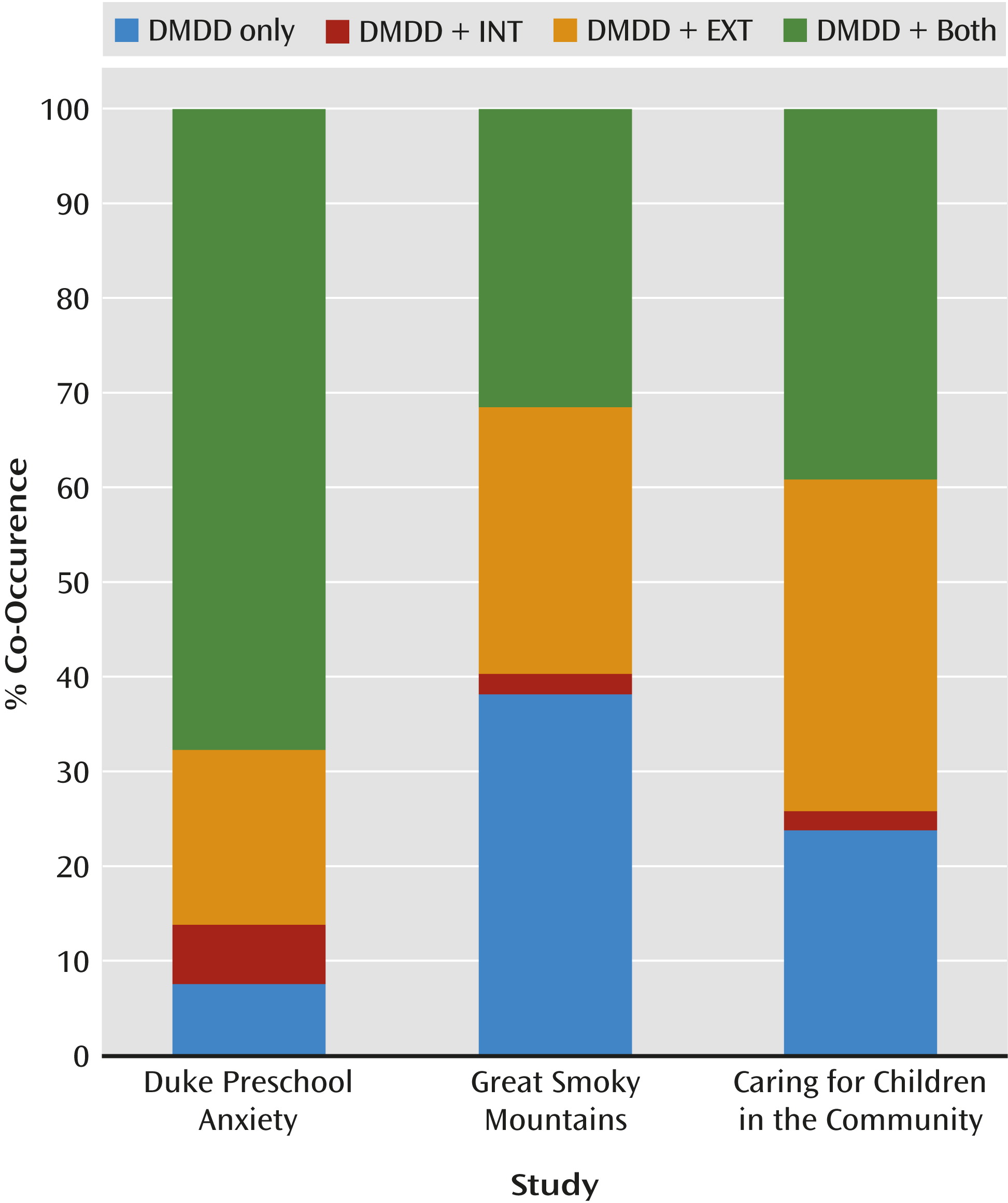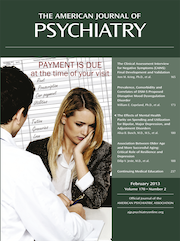Prevalence, Comorbidity, and Correlates of DSM-5 Proposed Disruptive Mood Dysregulation Disorder
Abstract
Objective
Method
Results
Conclusions
Method
Participants
| Characteristic | Duke Preschool Anxiety Study | Great Smoky Mountains Study | Caring for Children in the Community |
|---|---|---|---|
| Total subjects | 918 | 1,420 | 920 |
| Total observations | 918 | 5,336 | 1,627 |
| Informant | Parent only | Parent and self-report | Parent and self-report |
| Age (years) | mean=3.9 (SD=1.3, range=2–6) | mean=13.7 (SD=2.0, range=9–17) | mean=14.2 (SD=3.4, range=9–17) |
| % Female | 51.8 | 49.2 | 50.0 |
| Race/Ethnicity | |||
| White | 62.1% | 89.8% | 41.0% |
| African American | 37.5% | 6.4% | 53.8% |
| Native American | 3.8% | ||
| Other | 0.5% | 5.2% | |
| Interview | Preschool Age Psychiatric Assessment | Child and Adolescent Psychiatric Assessment | Child and Adolescent Psychiatric Assessment |
The Duke Preschool Anxiety Study.
The Great Smoky Mountains Study.
Caring for Children in the Community.
Measures
Disruptive mood dysregulation disorder.
Psychiatric comorbidities.
Impairments.
Sociodemographic correlates.
Service use.
Analytic Strategy
Results
Prevalence Rates
| Duke Preschool Anxiety Study (N=918) | Great Smoky Mountains Study (N=5,336) | Caring for Children in the Community (N=1,627) | ||||
|---|---|---|---|---|---|---|
| Criterion | N | % | N | % | N | % |
| A. Severe tantrums | 769 | 80.8 | 2,465 | 45.7 | 871 | 49.0 |
| B. Frequency | 182 | 17.7 | 514 | 7.1 | 140 | 6.3 |
| C. Negative mood | 268 | 21.1 | 798 | 12.8 | 179 | 8.2 |
| D. Duration | 92 | 5.9 | 221 | 2.8 | 42 | 1.5 |
| E. Multiple settings | 116 | 10.1 | 229 | 2.8 | 101 | 3.8 |
| Excluding onset criterion | 99 | 1.2 | 33 | 0.9 | ||
| Excluding duration criterion | 143 | 1.6 | 47 | 1.2 | ||
| Full criteria | 58 | 3.3 | 89 | 1.1 | 31 | 0.8 |
Comorbidity
| Rate of DMDD (%) | Rate of Diagnosis (%) | ||||||
|---|---|---|---|---|---|---|---|
| Comorbidity | Diagnosis | No Diagnosis | DMDD | No DMDD | Odds Ratio | 95% CI | p |
| Duke Preschool Anxiety Study | |||||||
| Depressive | 23.0 | 2.9 | 12.4 | 1.4 | 9.9 | 4.1–23.7 | <0.0001 |
| Anxiety | 7.5 | 1.3 | 72.9 | 30.7 | 6.1 | 1.9–19.0 | 0.002 |
| ODD | 37.7 | 1.1 | 67.7 | 3.8 | 52.9 | 17.1–163.8 | <0.0001 |
| Conduct disorder | 9.7 | 2.8 | 22.1 | 7.0 | 3.8 | 1.5–9.3 | 0.004 |
| ADHD | 23.5 | 2.4 | 30.8 | 3.4 | 12.6 | 4.0–39.6 | <0.0001 |
| Great Smoky Mountains Study | |||||||
| Depressive | 15.6 | 0.8 | 32.7 | 2.1 | 23.5 | 9.9–56.1 | <0.0001 |
| Anxiety | 5.5 | 1.0 | 9.3 | 1.8 | 5.2 | 1.2–22.9 | 0.03 |
| ODD | 23.3 | 0.5 | 57.4 | 2.2 | 61.0 | 27.7–134.4 | <0.0001 |
| Conduct disorder | 10.9 | 0.9 | 23.1 | 2.1 | 11.9 | 3.4–41.0 | <0.0001 |
| ADHD | 9.2 | 1.1 | 6.3 | 0.7 | 7.6 | 2.9–19.7 | <0.0001 |
| Caring for Children in the Community | |||||||
| Depressive | 11.8 | 0.8 | 35.8 | 3.2 | 16.3 | 6.3–42.1 | <0.0001 |
| Anxiety | 2.5 | 1.1 | 7.7 | 3.6 | 2.2 | 0.6–8.2 | 0.25 |
| ODD | 27.0 | 0.4 | 70.6 | 2.3 | 103.0 | 40.1–264.2 | <0.0001 |
| Conduct disorder | 5.3 | 1.0 | 18.8 | 4.0 | 4.4 | 1.2–15.3 | 0.02 |
| ADHD | 4.3 | 1.1 | 9.4 | 1.8 | 2.9 | 0.4–23.3 | 0.32 |

Impairment, Service Use, and Sociodemographic Correlates
| Great Smoky Mountains Study | Caring for Children in the Community | |||||||||
|---|---|---|---|---|---|---|---|---|---|---|
| Criterion | DMDD (%) | No DMDD (%) | Odds Ratio | 95% CI | p | DMDD (%) | No DMDD (%) | Odds Ratio | 95% CI | p |
| Impairment | ||||||||||
| Parental relations | 57.3 | 7.0 | 17.2 | 8.2–36.1 | <0.0001 | 64.4 | 11.1 | 12.3 | 5.2–29.2 | <0.0001 |
| Sibling relations | 25.4 | 3.8 | 7.7 | 2.6–22.7 | 0.0002 | 66.2 | 6.8 | 24.3 | 10.7–55.3 | <0.0001 |
| Teacher relations | 16.5 | 2.0 | 8.5 | 2.7–26.8 | 0.0003 | 55.1 | 4.5 | 20.9 | 10.2–42.7 | <0.0001 |
| School suspension | 35.1 | 4.2 | 11.4 | 4.4–30.0 | <0.0001 | 38.3 | 8.6 | 6.0 | 2.8–12.9 | <0.0001 |
| Service use | ||||||||||
| Mental health | 31.5 | 6.0 | 6.5 | 2.6–16.3 | <0.0001 | 39.8 | 4.7 | 13.8 | 4.7–40.5 | <0.0001 |
| General medical | 8.0 | 3.3 | 2.6 | 1.3–5.1 | 0.006 | 0.0 | 2.4 | |||
| School system | 26.0 | 7.5 | 4.1 | 1.7–9.7 | 0.002 | 37.5 | 8.7 | 6.8 | 2.2–20.5 | 0.0008 |
| Child welfare | 15.4 | 1.3 | 13.1 | 3.6–47.9 | 0.0001 | 5.8 | 0.6 | 10.2 | 1.4–75.3 | 0.02 |
| Juvenile justice | 8.8 | 1.8 | 4.1 | 0.6–27.7 | 0.15 | 28.4 | 1.0 | 16.1 | 4.6–56.5 | <0.0001 |
| Any | 54.2 | 18.0 | 4.5 | 2.1–9.7 | 0.001 | 60.8 | 14.0 | 9.6 | 3.2–28.2 | <0.0001 |
| Sociodemographic | ||||||||||
| Impoverished | 42.9 | 19.0 | 3.0 | 1.3–6.9 | 0.01 | 66.2 | 31.9 | 4.1 | 1.6–10.4 | 0.003 |
| Single-parent family | 40.0 | 23.7 | 2.2 | 1.0–4.9 | 0.05 | 26.1 | 14.7 | 2.0 | 0.8–48.0 | 0.12 |
| Low parent education | 19.4 | 17.3 | 1.3 | 0.5–3.2 | 0.61 | 61.8 | 42.7 | 2.1 | 0.9–4.9 | 0.09 |
Discussion
Conclusions
References
Information & Authors
Information
Published In
History
Authors
Funding Information
Metrics & Citations
Metrics
Citations
Export Citations
If you have the appropriate software installed, you can download article citation data to the citation manager of your choice. Simply select your manager software from the list below and click Download.
For more information or tips please see 'Downloading to a citation manager' in the Help menu.
View Options
View options
PDF/EPUB
View PDF/EPUBLogin options
Already a subscriber? Access your subscription through your login credentials or your institution for full access to this article.
Personal login Institutional Login Open Athens loginNot a subscriber?
PsychiatryOnline subscription options offer access to the DSM-5-TR® library, books, journals, CME, and patient resources. This all-in-one virtual library provides psychiatrists and mental health professionals with key resources for diagnosis, treatment, research, and professional development.
Need more help? PsychiatryOnline Customer Service may be reached by emailing [email protected] or by calling 800-368-5777 (in the U.S.) or 703-907-7322 (outside the U.S.).

